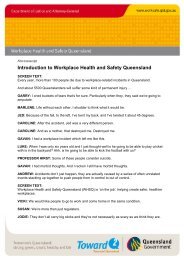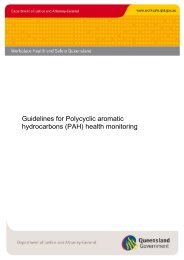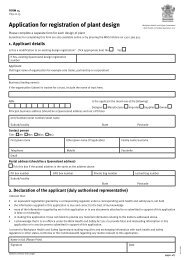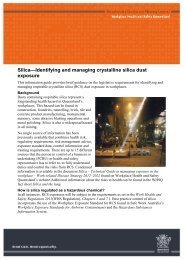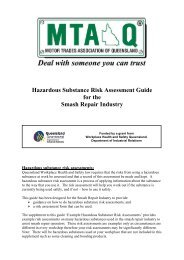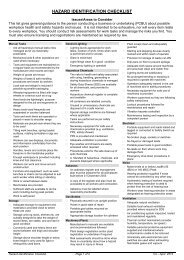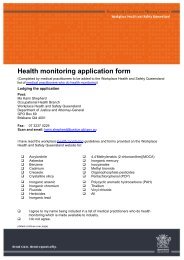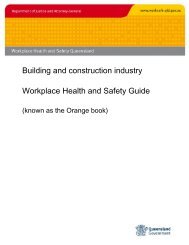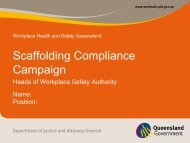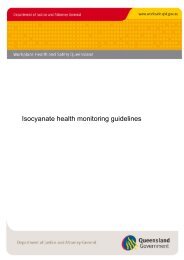Meat processing injury hotspotd
Meat processing injury hotspotd
Meat processing injury hotspotd
Create successful ePaper yourself
Turn your PDF publications into a flip-book with our unique Google optimized e-Paper software.
Health and safety tipsEmployers should work with their employees and health and safety representatives to identify hazards, assess the risk of <strong>injury</strong> anddetermine the most effective solutions to prevent or minimise the risk. Below are some common control measures known to reduce therisk of <strong>injury</strong>.Knives and sawsActivities/instructions• Use the correct knife for the task.• Provide mechanical sharpening systems.• All people using knives on the kill floor must wear handprotection to prevent lacerations and support good grip (e.g.rubber Kevlar gloves).• Use a chain mesh apron and arm guard when using a knife forslaughtering, slicing or boning.• Workers should receive competency-based training in theselection, use and sharpening of knives.• Ensure carcass temperatures support the smoothest possiblecutting, particularly for hard beef.Manual tasksFor work involving hard physical effort• Use mechanical aids, such as meat tensioning equipment whenboning meat.• When pelting hides, use rails to present the task at heights thatreduce the need to bend and reach or use a hide puller.• For head removal, use a mechanical aid to support the weightof the head.• Use low resistance hooks to reduce push forces.• Transfer offal tubs using mechanical aids such as trollies andempty by mechanical means (e.g. tipping chutes or wherepracticable, use floor chutes and conveyors).• If meat lumping is unavoidable (e.g. transporting from a vehicleto a retailer), use a linkage rail system.• Maintain a good working distance between other workers whoare using knives.• Use engineering design for safety barriers, guards ormechanical feeding to minimise the likelihood of injuriescaused by blades or cutters. Use height adjustable guards onbandsaws, two-handed operation for hock and brisket cutters,and install feed-in systems for bandsaws.• Avoid knife handles with ridges and contours, which canincrease discomfort.• Provide accessible first aid equipment and trained first aid officers.• When unloading chillers and pushing sides of product, useoverhead gravity rails set to a small gradient to reduce physicalexertion.• Eliminate carrying carcasses by hand (e.g. boxing andpalletising meat, by using chain and hook systems).• Use plate freezers or trolley systems for loading and unloadingfreezer frames.• Use forklift and slipsheets with pre-palletising and use forkliftpush-pull attachments when stacking shipping containers.• Use mechanical lifting devices for heavy weights in trolleybins containing viscera from the kill floor or vacuum lifters forpackaged products.For activities involving awkward or static positions, repetition and vibration• Design working spaces such as platforms so that workers areable to work in a comfortable upright position with arms heldclose to the body (e.g. tool rests and sterilizers are positionedappropriately).• Ensure the carcass is kept as vertical and close to the platformedge as possible to reduce horizontal reach.• Use mechanised height adjustable platforms, stands and tablesand appropriate chain height to keep the carcass in a goodworking zone for each task.• Adjust work spaces to allow for different working heights fordifferent sized workers (e.g. when pelting mutton use rails thathold the beast in place and at the right height for the worker,and boning tasks are kept between worker shoulder andwaist height).• Use meat tensioning equipment when doing repetitive or longtasks such as boning.Slips, trips and fallsActivities/instructions• Ensure floor surfaces are appropriate for the work being doneand are non-slip.• Ensure footwear is suitable for the type of work andenvironment, has a non-slip sole and appropriate tread patternand is checked regularly to ensure treads are not worn away orclogged with contaminants.• A ‘cleandown’ procedure (involving the swift removal of blood,fats and residues, including in evisceration and sticking areas)should be followed throughout the shift, not just at the end.Ensure workers have a good understanding of the procedure.• Restrain tool balancers and leads to prevent trip hazards.• Use trolleys to keep loads at heights that don’t need workers tobend when pushing or lifting such as trolleys for tubs of offal.• Use mechanised wrapping equipment to reduce repetitivehandling such as when wrapping pallets.• Counterbalance heavy equipment to reduce the need to supportthe weight and sustained holding.• Use tools which produce the least vibration or have vibrationisolatedhandles.• Design jobs so that workers have a variety of tasks whichallow use of different postures and muscle groups. If this is notpossible consider administrative controls such as job rotation.• Ensure loading and unloading is done at waist level or betweenshoulders and mid thighs. For example, use height adjustableracking and trolleys, pallet lift tables or vacuum lifters.• Use barriers and railings to prevent falls and falling objects. Usefalls restraint equipment on platforms and/or restrict accesswhere necessary.• While cleaning, workers should wear personal protectiveequipment, including protection against scalding.• Keep work areas clean and tidy.• Keep equipment and floor surfaces clean and well maintained.• Mark walkways and exclusion zones around work areas. Markedges of equipment and ensure adequate lighting.• Ensure sterilisers and wash basins are located and plumbedappropriately, to reduce water on platforms and floors.JAG 11/3999For further information visit www.worksafe.qld.gov.auor call the Workplace Health and Safety Infoline on 1300 369 915.





